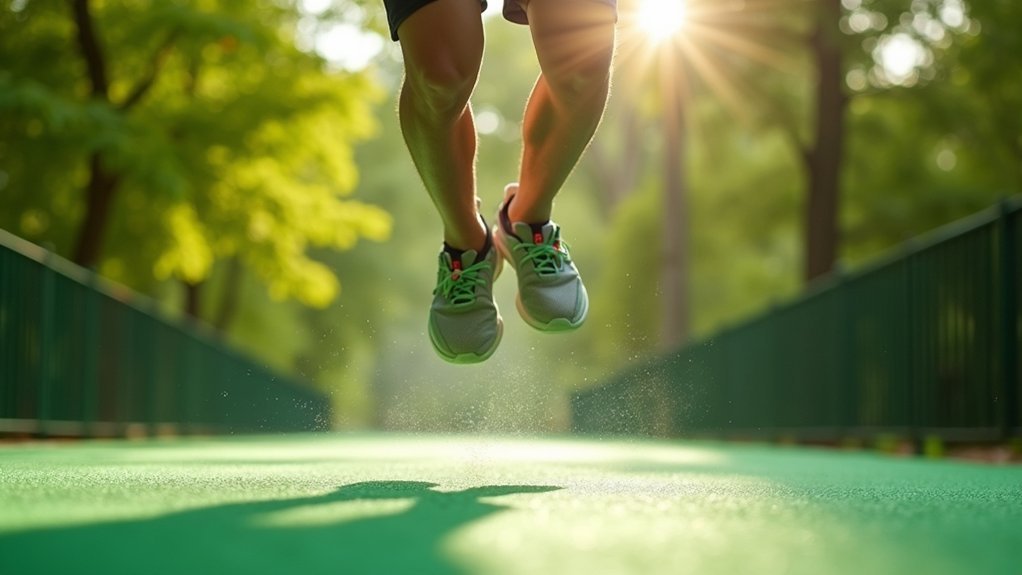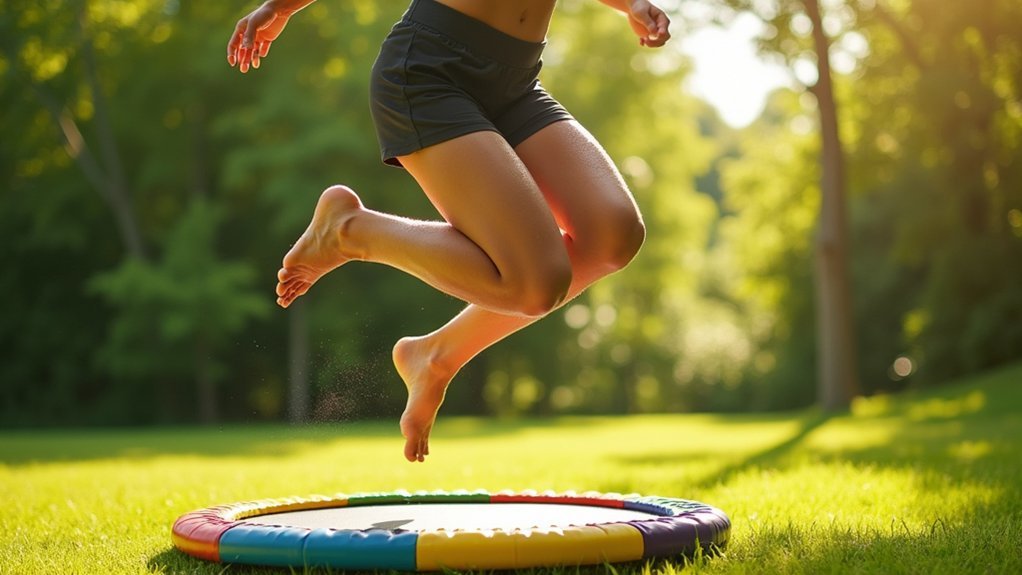Mini-jumping reduces body inflammation by activating your lymphatic system, which removes cellular waste and toxins. The rhythmic up-and-down motion creates unique g-forces that flush inflammation markers while enhancing immune function. NASA research confirms rebounding increases lymphocyte activity more effectively than traditional exercises, providing gentle, zero-impact movement ideal for arthritis sufferers. You’ll experience both immediate relief and long-term benefits when you incorporate this science-backed technique into your routine just 20 minutes, three times weekly.
The Science Behind Rebounding and Inflammation

While many exercise forms claim anti-inflammatory benefits, rebounding stands out with compelling scientific evidence supporting its effectiveness.
When you bounce on a mini-trampoline, you create a unique environment where gravity and momentum work together to enhance your body’s natural anti-inflammatory processes.
NASA research confirms that rebounding increases gForce and lymphocyte activity, directly combating inflammation at the cellular level. This gentle bouncing motion stimulates lymphatic flow—a critical system that removes inflammatory waste from your tissues.
Rebounding creates a zero-impact environment where cells experience enhanced gForce, activating your body’s natural anti-inflammatory defenses.
Unlike walking or cycling, rebounding creates a pumping action that efficiently moves lymph fluid throughout your body.
Studies published in BMC Musculoskeletal Disorders demonstrate why rebounding outperforms traditional exercises for conditions like osteoarthritis and rheumatoid arthritis—it provides targeted relief while improving joint function with less stress.
How Mini-Jumping Activates the Lymphatic System
Your rebounding sessions on a mini-trampoline turbocharge lymphatic drainage, effectively pumping lymph fluid through your body’s intricate vessel network.
The rhythmic up-and-down motion creates alternating pressure and release that helps flush cellular waste and toxins from your tissues.
This waste removal process directly supports your immune function and helps your body manage inflammation more efficiently.
Lymphatic Drainage Enhancement
Because our bodies rely on consistent movement to flush out toxins, mini-jumping provides a uniquely effective way to activate the lymphatic system. The repetitive bouncing motion creates a pumping effect that stimulates one-way valves in your lymph vessels, greatly enhancing lymphatic drainage throughout your body.
When you rebound on a mini-trampoline, you’ll experience three key benefits:
- Increased gForce that activates lymphocytes, boosting your immune function
- Improved circulation of lymph fluid, reducing swelling and inflammation
- Enhanced removal of metabolic waste without stressing your joints
Unlike high-impact exercises that can aggravate inflammation, mini-jumping offers a gentle yet effective approach to lymphatic drainage. Your body can efficiently eliminate toxins while you enjoy a low-impact workout that’s suitable even if you’re dealing with inflammation-related conditions.
Cellular Waste Removal
At the cellular level, mini-jumping stimulates a powerful waste removal process that traditional exercises simply can’t match.
When you bounce on a trampoline, the unique acceleration and deceleration forces activate your lymphatic vessels more effectively than walking or cycling.
Your lymphatic system lacks a central pump like your heart, relying instead on muscle movement and gravitational changes to flow properly.
Mini-jumping creates the perfect conditions for this system to function efficiently. Each bounce helps flush cellular waste and toxins that would otherwise accumulate and trigger inflammation.
This enhanced lymphatic circulation increases lymphocyte activity, boosting your immune function while reducing swelling and inflammation throughout your body.
For those with arthritis or autoimmune conditions, this gentle but effective drainage mechanism helps alleviate chronic inflammation that contributes to ongoing health issues.
Cellular Impact: G-Forces and Anti-Inflammatory Responses

The g-forces generated during mini-jumping create cellular vibration that triggers anti-inflammatory responses throughout your body.
Your lymphatic system accelerates its cleansing function during these controlled bounces, flushing out toxins that contribute to chronic inflammation.
Each jump strengthens your mitochondria—the cellular powerhouses—enhancing energy production and reducing inflammatory markers that compromise tissue health.
G-Force Cellular Benefits
While conventional exercise benefits your body in numerous ways, mini-jumping creates a unique cellular environment through G-forces that dramatically amplifies these effects.
When you bounce on a mini-trampoline, your cells experience alternating weightlessness and increased gForce, triggering powerful anti-inflammatory responses at the cellular level.
These gForce benefits include:
- Enhanced metabolic activity – Cells respond to mechanical stress by accelerating detoxification processes and improving overall cellular function.
- Increased lymphatic flow – The rhythmic compression and decompression stimulates your lymphatic system, flushing inflammatory toxins more efficiently.
- Strengthened cellular structure – NASA research shows rebounding’s mechanical impact helps rejuvenate tissues, potentially reducing joint inflammation and pain.
This cellular stimulation releases endorphins that further combat inflammation while providing natural pain relief.
Lymphatic System Acceleration
Understanding your body’s lymphatic system brings the cellular G-force benefits of mini-jumping into sharper focus. Unlike your cardiovascular system, your lymphatic network lacks a pump, making rebounding uniquely crucial for stimulating lymph flow.
When you mini-jump, the alternating acceleration and deceleration creates a pumping effect that NASA studies confirm dramatically enhances lymphatic drainage and reduces inflammation throughout your body.
| Lymphatic Benefit | Mini-Jumping Effect |
|---|---|
| Fluid Retention | Reduces swelling through enhanced drainage |
| Immune Function | Increases lymphocyte activity and efficiency |
| Inflammatory Response | Accelerates removal of inflammatory compounds |
You’ll experience improved circulation at the cellular level during rebounding, delivering essential nutrients while flushing away inflammatory waste products more effectively than walking or cycling—making this gentle exercise particularly beneficial for those with arthritis and chronic inflammation.
Mitochondrial Health Enhancement
At the heart of mini-jumping’s remarkable anti-inflammatory benefits lies its profound impact on your mitochondria—those tiny cellular powerhouses that generate energy for every bodily function.
When you bounce, you’re subjecting your body to increased g-forces that stimulate mitochondrial activity, triggering cellular repair mechanisms vital for reducing inflammation.
Your mitochondrial health enhancement occurs through three key processes:
- Increased g-forces during rebounding accelerate mitochondrial energy production, providing cells with the resources needed to combat inflammation.
- Mechanical stimulation boosts lymphocyte activity, strengthening your immune system’s anti-inflammatory responses.
- Enhanced oxidative stress management results from improved mitochondrial function, neutralizing free radicals that contribute to chronic inflammation.
You’re fundamentally training your cells to become more efficient at energy production while simultaneously supporting your body’s natural inflammatory regulation systems.
Comparing Rebounding to Traditional Exercises for Inflammation

When traditional exercises fail to provide relief for inflammation sufferers, rebounding emerges as a superior alternative with compelling scientific support.
Research published in BMC Musculoskeletal Disorders confirms that rebounding offers greater pain reduction and improved joint function compared to walking for osteoarthritis patients.
Rebounding delivers superior pain relief and mobility benefits over walking for those struggling with osteoarthritis.
You’ll find rebounding outperforms cycling for rheumatoid arthritis symptoms while delivering unique acceleration-deceleration patterns that enhance lymphatic drainage—a key factor in fighting inflammation.
NASA’s findings demonstrate rebounding’s ability to increase gForce and stimulate lymphocyte activity, boosting your immune response more effectively than conventional exercises.
Unlike high-impact workouts, rebounding allows you to maintain cardiovascular exercise without aggravating painful joints, making it an ideal choice if you’re battling inflammation-related conditions but still need consistent physical activity.
Research-Backed Benefits for Joint Health and Arthritis
Your mini-trampoline workouts provide exceptional joint impact absorption compared to ground-based exercises, allowing you to move freely with up to 87% less pressure on your joints.
Research published in BMC Musculoskeletal Disorders confirms rebounding outperforms walking for improving joint function and reducing pain in osteoarthritis patients.
The gentle bouncing motion stimulates measurable reductions in inflammatory markers while increasing lymphocyte activity, creating a dual benefit for those managing arthritis or joint inflammation.
Joint Impact Absorption
Unlike high-impact exercises that can stress already vulnerable joints, rebounding on a mini trampoline offers exceptional joint protection through its natural shock absorption properties.
The flexible surface absorbs up to 87% of the impact that would otherwise travel through your knees, hips, and spine during traditional exercises like running or jumping on hard surfaces.
Studies confirm that this joint impact absorption mechanism makes rebounding particularly beneficial for those with arthritis:
- Research in BMC Musculoskeletal Disorders shows rebounding outperforms walking for improving joint function in osteoarthritis patients.
- People with rheumatoid arthritis experience better joint mobility compared to cycling.
- The gentle bouncing motion activates lymphatic drainage that reduces inflammation without aggravating joint pain.
This makes mini-trampolines an ideal exercise option for maintaining mobility despite joint conditions.
Inflammatory Marker Reduction
Scientific evidence strongly supports rebounding’s ability to reduce key inflammatory markers in the body. Research published in BMC Musculoskeletal Disorders confirms that rebounding outperforms traditional walking exercises for osteoarthritis patients, markedly improving joint function while reducing pain.
You’ll experience more effective inflammatory marker reduction with rebounding compared to cycling if you have rheumatoid arthritis. This gentle bouncing motion stimulates your lymphatic system—a vital mechanism for eliminating inflammatory waste products.
NASA research further validates these benefits, showing that rebounding’s unique g-force patterns boost lymphocyte activity, enhancing your immune response against inflammation.
If you suffer from lipidemia or other inflammatory conditions, the enhanced lymphatic drainage you’ll get from regular rebounding sessions helps reduce swelling while addressing root causes of joint inflammation rather than merely masking symptoms.
Rebounding’s Role in Reducing Systemic Inflammation
While many exercise modalities offer anti-inflammatory benefits, rebounding stands out as a particularly effective option for reducing systemic inflammation. The unique acceleration and deceleration forces experienced during mini-jumping activate your lymphatic system, helping to flush toxins from your body more efficiently than traditional exercises like walking or cycling.
Rebounding can help manage inflammation through:
Rebounding gently activates your lymphatic system, reducing inflammation while strengthening immunity without stressing your joints.
- Enhanced lymphatic drainage – The gentle bouncing motion stimulates lymph flow, essential for removing inflammatory waste products.
- Increased gForce effect – NASA research shows this boosts lymphocyte activity, strengthening your immune response.
- Joint-friendly impact – Studies indicate rebounding improves joint function while reducing pain in arthritis patients.
For those with chronic inflammatory conditions like lipidemia, regular rebounding offers a low-impact alternative that reduces swelling while supporting cardiovascular health.
The Connection Between Lymphatic Flow and Reduced Swelling
When your lymphatic system functions ideally, swelling throughout your body noticeably decreases. Rebounding directly stimulates this essential system through the unique acceleration and deceleration patterns created during mini-jumping sessions.
As you bounce, lymphatic vessels contract more efficiently, increasing the circulation of lymph fluid that removes toxins and excess fluid from your tissues. This enhanced lymphatic flow is vital for reducing inflammation and swelling in your body.
Each jump on a mini-trampoline creates momentary increases in gForce that physically push lymph through your system, allowing for more effective removal of inflammatory substances.
The increased activity of lymphocytes during rebounding further supports your immune function and helps manage inflammation long-term. Regular rebounding creates sustainable improvements in your lymphatic circulation, contributing to lasting relief from swelling.
Optimal Rebounding Techniques for Maximum Anti-Inflammatory Effects
To achieve maximum inflammation reduction from your mini-trampoline exercise, specific rebounding techniques make all the difference. Commit to at least 20 minutes of rebounding three to four times weekly to properly stimulate your lymphatic system and enhance anti-inflammatory effects.
Consistent rebounding activates your lymphatic system, the key to reducing systemic inflammation and boosting recovery.
- Mix up your movements – Incorporate gentle bouncing, side-to-side hops, and knee lifts to improve joint mobility and reduce inflammation more effectively.
- Maintain proper posture – Keep your core engaged and shoulders relaxed while rebounding to prevent strain and optimize joint health benefits.
- Progress gradually – Slowly increase intensity over time, as progressive overload improves joint function and reduces symptoms of inflammatory conditions.
Pair your rebounding routine with anti-inflammatory foods to amplify the benefits and further reduce body inflammation.
Combining Rebounding With Anti-Inflammatory Lifestyle Changes
Although rebounding alone offers impressive anti-inflammatory benefits, integrating complementary lifestyle changes greatly amplifies these effects.
Pairing your rebounding routine with a Mediterranean diet rich in fruits, vegetables, and omega-3s creates a powerful synergy that further reduces systemic inflammation.
Don’t underestimate the importance of stress management—incorporating yoga or meditation alongside your rebounding sessions markedly lowers chronic inflammation by reducing stress hormones.
Prioritize quality sleep with a consistent schedule to optimize recovery and enhance the anti-inflammatory benefits of your mini-jumping practice.
Strengthen your core muscles through targeted exercises to improve stability during rebounding, maximizing results while preventing injury.
Finally, avoid tobacco and limit processed foods to create a thorough approach that tackles inflammation from multiple angles, boosting your overall health outcomes.
Success Stories: Real People’s Inflammation Reduction Through Rebounding
The transformative impact of rebounding on inflammation is perhaps best illustrated through real-life success stories. Many individuals have documented their journeys from pain to relief through consistent mini-jumping routines.
- Osteoarthritis patients have reported significant pain reduction and improved joint mobility after incorporating rebounding into their exercise regimens, as confirmed by BMC Musculoskeletal Disorders research.
- Rheumatoid arthritis sufferers experienced enhanced joint function with rebounding compared to traditional cycling, highlighting unique benefits of this low-impact exercise.
- People with lipidemia witnessed reduced swelling and discomfort through regular rebounding sessions.
These testimonials reinforce NASA’s findings that rebounding increases lymphocyte activity and enhances immune response.
The benefits of rebounding extend beyond physical improvements to overall well-being and health, making it a powerful tool against chronic inflammation.
Getting Started: Equipment Selection for Therapeutic Rebounding
Selecting the right mini-trampoline forms the foundation of an effective therapeutic rebounding practice.
Look for a model with a sturdy frame and non-slip surface to guarantee safety during your anti-inflammatory workouts.
Choose a mini trampoline with adjustable tension or springs so you can customize bounce intensity to match your fitness level. A diameter of 36-40 inches provides ample space for effective exercises while fitting comfortably in most homes.
Always check the weight capacity—opt for a rebounder that supports at least 50-100 pounds more than your current weight. This guarantees stability and longevity of your equipment.
If you’re new to rebounding or have balance concerns, consider models with stability bars or handles for added support and confidence during your inflammation-fighting sessions.
Creating an Effective Rebounding Routine for Long-Term Inflammation Management
When designing your rebounding practice for inflammation management, consistency becomes the cornerstone of success. Commit to 20-30 minute sessions at least three times weekly to stimulate lymphatic drainage and improve overall circulation, reducing chronic inflammation over time.
Incorporate these elements for maximum benefit:
- Variety of movements – Include basic jumps, twists, and squats to engage different muscle groups and enhance joint function.
- Progressive intensity – Gradually increase your rebounding difficulty to amplify anti-inflammatory benefits and cardiovascular fitness.
- Complementary practices – Pair rebounding with Mediterranean diet choices rich in anti-inflammatory foods.
Don’t forget proper warm-up and cool-down periods to prevent injury while maximizing lymphatic flow benefits, especially important for osteoarthritis and rheumatoid arthritis patients.
Frequently Asked Questions
Does Rebounding Help With Inflammation?
Yes, rebounding helps with inflammation. You’ll benefit from its lymphatic drainage stimulation, reduced joint pain, improved immune responses through gForce exposure, and decreased swelling. It’s especially effective when combined with healthy eating habits.
What Is the Best Exercise to Reduce Inflammation in the Body?
While rebounding is excellent for inflammation reduction, you’ll also benefit from swimming, yoga, and walking. These low-impact exercises improve circulation, stimulate lymphatic drainage, and reduce inflammatory markers without stressing your joints.
Why Does Movement Reduce Inflammation?
Movement reduces inflammation because you’re stimulating blood circulation, releasing anti-inflammatory cytokines, improving lymphatic flow, decreasing stress hormones, and enhancing metabolic health. Together, these processes help your body naturally lower inflammatory responses and promote healing.
Does Jumping Clear the Lymphatic System?
Yes, jumping does clear your lymphatic system. When you bounce, you create gravitational changes that stimulate lymph flow, helping remove toxins and waste from your body since your lymphatic system lacks its own pump.
In Summary
You’ve now discovered mini-jumping’s powerful anti-inflammatory effects through its unique ability to stimulate lymphatic flow, create beneficial cellular G-forces, and reduce joint stress. By incorporating regular rebounding into your routine, you’ll improve circulation, decrease systemic inflammation, and enhance your overall well-being. Start with proper equipment and a consistent schedule—you’ll likely notice reduced pain and increased mobility within weeks of beginning this gentle yet effective exercise approach.





Leave a Reply